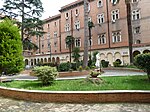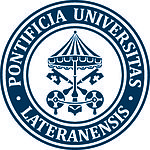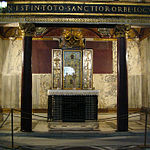Sant'Antonio da Padova in Via Merulana

The Basilica of Saint Anthony of Padua al Laterano (Italian: Sant'Antonio da Padova all'Esquilino, Latin: S. Antonii Patavini de Urbe) is a Roman Catholic titular church in Rome on Via Merulana, one block from the Obelisk of St. John Lateran. It was built for the Order of Friars Minor, who needed a new home after they were moved from Santa Maria in Ara Coeli to allow the construction of the Victor Emmanuel II Monument. The church was consecrated on 4 December 1887 and was elevated to minor basilica status in 1931.On 12 March 1960 Pope John XXIII made it a titular church as a seat for cardinals. The most recent cardinal priest of the Titulus Sancti Antonii Patavini de Urbe was Cláudio Hummes.
Excerpt from the Wikipedia article Sant'Antonio da Padova in Via Merulana (License: CC BY-SA 3.0, Authors, Images).Sant'Antonio da Padova in Via Merulana
Via Merulana, Rome Municipio Roma I
Geographical coordinates (GPS) Address External links Nearby Places Show on map
Geographical coordinates (GPS)
| Latitude | Longitude |
|---|---|
| N 41.888808333333 ° | E 12.503944444444 ° |
Address
Basilica di Sant'Antonio da Padova all'Esquilino
Via Merulana
00183 Rome, Municipio Roma I
Lazio, Italy
Open on Google Maps











